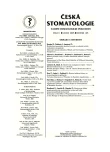Bonded Amalgam Filling – Part II: Clinical Evaluation after 7, 8 and 9 Years
Authors:
E. Ložeková 1; Z. Mach 2
Authors‘ workplace:
Výzkumný ústav stomatologický 1. LF UK a VFN, Praha
přednostka prof. MUDr. J. Dušková, DrSc.
1; S. O. S., soukromá stomatologická ordinace, Praha
2
Published in:
Česká stomatologie / Praktické zubní lékařství, ročník 105, 2005, 1, s. 15-19
Overview
Clinical evaluation of quality of marginal occlusion of bonded amalgam filling and its comparison with a classical amalgam filling after seven, eight and nine years since it was made follows up the previous laboratory and clinical observation of bonded and classical amalgam fillings, respectively. The results of evaluation after two, four, five and six years since these fillings were made have already been published.
At the beginning of the study (in 1994), a total of 137 fillings were made, 75 of them bonded and 62 control amalgam fillings of 1st and 2nd class according to Black in lateral segment of dentition in 21 patients. Clinical evaluation of the filling quality was performed in annual intervals according to modified USPHS criteria.
The most important clinical advantages of bonded amalgam filling include its firmer fixation in the cavity, which excludes the need of retention preparation and protects the healthy tooth tissue. Another advantage is an increased resistance of the tooth treated in this way against fracture, decreased postoperative sensitivity, more efficient prevention of the origin of microfissure by means of resin adhesives and subsequent decrease of the risk of secondary caries. The bonded amalgam filling can be particularly well used in reconstruction of more extensive caries defects in teeth of lateral segment of dentition. This kind of technique makes it possible to eliminate, in some cases, the use of retention pins and to avoid risk their application brings about.
The results of this longitudinal study have shown that for the whole period of nine years of clinical observation none of the criteria under observation have shown significant differences between adhesive and control fillings. In order to confirm a higher success of this adhesion method another long-term clinical and laboratory observation would be useful aimed at demonstration of a higher resistance of the bonded amalgam filling in comparison with classical amalgam filling.
Key words:
amalgam – bonded amalgam filling – quality of marginal filling occlusion
Labels
Maxillofacial surgery Orthodontics Dental medicineArticle was published in
Czech Dental Journal

2005 Issue 1
Most read in this issue
- Corrosion Resistance of Titanium in Dentistry Applications
- Evaluation of the Effect of Propriosensitive Re-education Exercise in the Therapy of Temporomandibular Disorders
- Bonded Amalgam Filling – Part II: Clinical Evaluation after 7, 8 and 9 Years
- Molecular Genetic Identity of Blood and Oral Isolates of Viridans Streptococci
